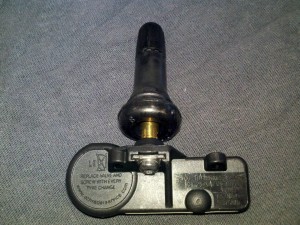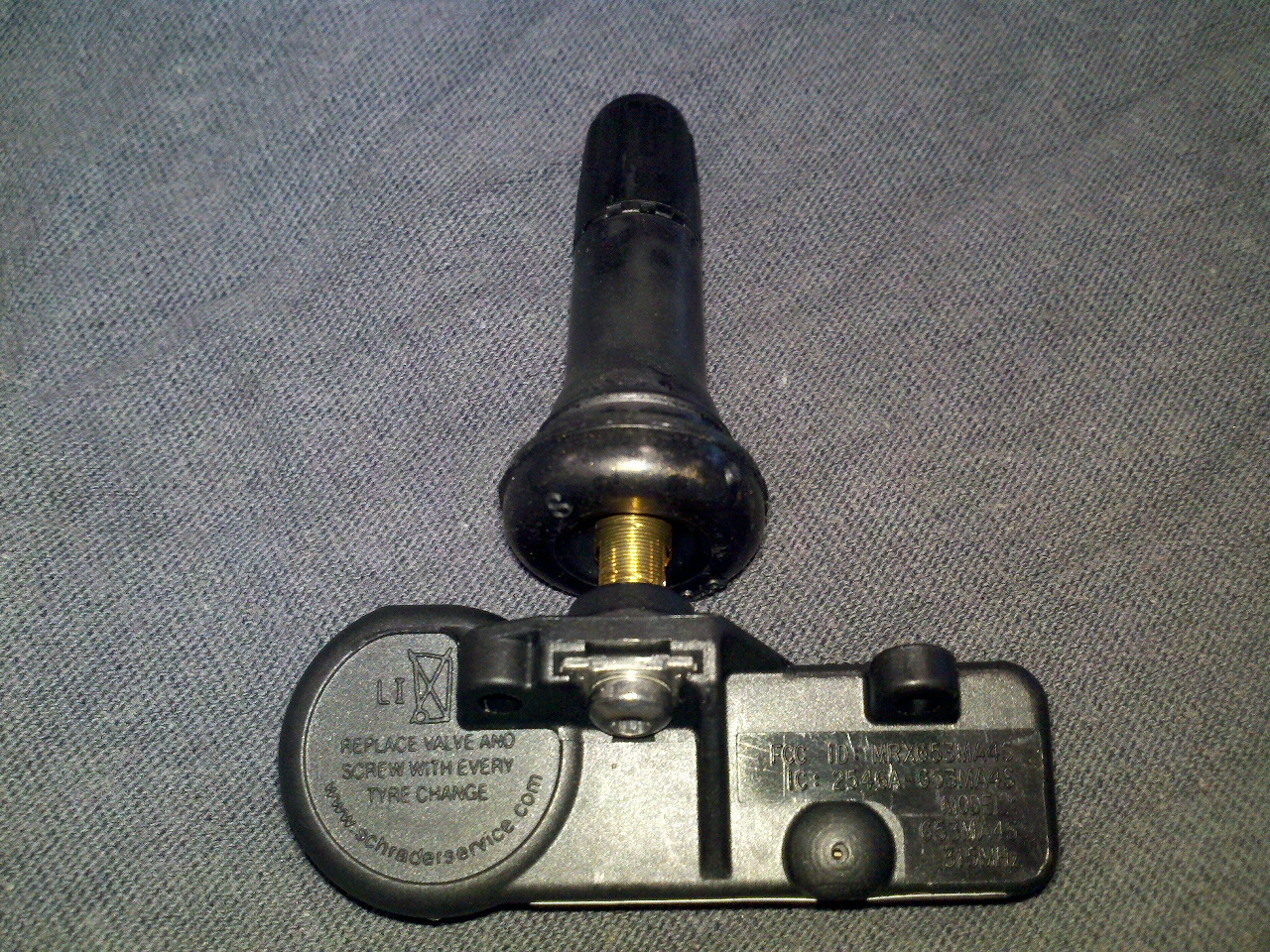Tire Pressure Monitor System
Description
The tire pressure monitor system was developed many years ago to alert the driver to a tire that is loosing air. As one or more tires lose air because of a leak as compared to the other tires, a warning light or message will come on the dash. A module or computer is used to monitor the system and has software calibration specifying at what percentage of air loss will turn on the warning. Each manufacture has a different range of air pressures loss that will set a warning.
This system has gone through many changes over the years. In the first few years the tire monitor warning system was used on cars and trucks, the ABS brake system would use the wheel speed sensors to monitor tire pressure. This is accomplished by looking at the speed of each wheel. As a tire looses air, it actually gets a smaller circumference. This in turn causes that wheel speed to be different than the others. The speed difference is not enough to cause an ABS brake problem. The calibration in the computer was able to detect very small changes is tire circumference by looking at a frequency change in the wheel speed sensors.
The latest and much better way of monitoring tire pressures in today’s vehicles uses a small radio frequency (RF) transmitter in each wheel. It is part of the valve stem. These send a signal to the computer or module of the actual tire pressures. See picture below. Early sensors on some vehicles where aluminum, but we found that after the vehicle got some mileage on it, and especially in areas of the country with bad winter weather, the sensor would corrode onto the wheel making it very difficult to remove if it ever needed to be replaced. The new sensor are plastic and rubber.

Tire Pressure Sensor
The actual warning portion of the system has also greatly improved. Early versions just turned on a small light on the dash. This would alert you that one or more of the tires is getting low, but would not tell you which one. All tires would need to be checked, and then the system reset. The next generation illuminated a warning light, and a message would come up on the drivers information center- if the vehicle has one, and would tell the driver “Check Tire Pressures”. This still would not tell the driver which tires was low. The next and current generation actually tells you which tires is low, and shows you the actual pressure in each wheel.
Most people do not understand the differences in the way the light functions. People really need to read the owners manual. Most do not understand that an indicator light on solid means a tire is low. A flashing indicator means that there is a problem in the pressure monitor system and it is not functioning properly. A faulty sensor is usually the cause for this. I cannot count how many times during the colder weather months that customers will come all the way into the repair shop stating the tire pressure system is not working because they see a light on the dash solid. Tires lose and gain air pressure depending on temperature. Customers do not even bother to check the owners manual, which would have instructed them to check the tires because one is getting low. People do not even look at their wheels. Most of the time you can tell which one is low. What did these people do 15 years ago. We have even seen customers come in saying the system is not working. The service advisor asks them why they think that, and they will say “Because the information center said that the right rear tire is low”. So, naturally they are asked if they checked that wheel. The response is always “No, I am sure it is fine”. Really? If your car is telling you that a certain tires is low, and to check it, why the heck don’t you check it ! That is what the tire pressure monitor system is there for!. Auto manufacturers have spent millions of dollars developing that system. It is also priced into the cost of a new vehicle. But these customers still don’t believe what the car is telling them. Again, what did they do years ago. I know what they did, they went down to the local gas station and put a quarter in the machine and pumped up their tire !
An important thing to remember is that on the newer cars and trucks, if you get your tires rotated as your maintenance schedule states, the person or shop doing the tire rotate needs to relearn the tire positions. The computer recognises which wheel is which by the radio frequency I.D. of the sensor. If a tire goes low after a rotation, the car will tell you the incorrect position of that wheel unless the positions are relearned. This takes a special signaling tool to do it properly. The same principal applies when replacing tires. Odds are the wheel not will go to the same location it was removed. Also, be ready to buy at least 1 new sensor if you are getting a set of tires replaced. It is quite common for one of the sensors to get damaged while removing or installing new tires. The mechanic needs to be very careful, and a special procedure is required to prevent damage. Some of the local repair shops have trouble doing this without damaging a sensor.
So if you see a little light come on the dash that looks like a tire, please just do yourself a favor and check the tire pressures. You can buy a small pressure gauge at any local parts store for $1.99. You can even buy a small air pump to keep in the trunk for under $40. This is also a great item for your emergency kit.
———-
Live Chat
I just bought a used 2008 Chevy Uplander and the “Service Tire monitor System” light came on while driving down the road. I’m not quite sure what this means and what I need to do to fix it.
ProTech:
That is the system that monitors the tire pressure. You could just have a low tire that needs filling.
I checked the tire and it looks to be fine. Also, when I looked at the tire pressure on the monitor all but one is registering. Could this be due to a sensor needing replaced.
Yes, you could have a bad sensor in the wheel that is not registering. You will have to take the Chevy dealership to get it checked it. It is not something you can replace yourself.
Could you tell me if this is an inexpensive fix or do I need to go after the dealer I got the vehicle from?
If you do require sensor replacement. The sensor itself is around $100, plus the labor to install it and program it to your vehicle. You can go to any GM dealer. If you don’t want to spend the money, and aren’t concerned about the light being on, just set the tire pressure and you can continue to drive just fine.
OK thank you very much for your time. Since the van isn’t quite 5 days old yet to me I might go to the dealer and try to get them to pay for it. Thank you again.
No problem at all, have a nice night!
———-
My front tires are worn unevenly but the back tires are still good. The tire shop says I need a front end alignment. My question is should I wait until I buy a new set of tires for the alignment or would it help the front tires wear long to do it now?
ProTech:
It would be wise to get a front end alignment soon if you are experiencing tire wear. I would recommend rotating the front tires to the back, and the back tires to the front, and also do an alignment. That would get you by for quite a while. No need to buy tires sooner than you have to.
Leave comments below or see these


Leave A Comment, Reply Or Ask A Question
2 Comments on "Tire Pressure Light Description and Operation"
I have a 2000 Volvo s80. I removed the abs module to solder it. After removing it I realized that I left the windows down. Now I have no battery power, does the module have to be in for the battery to work?
You can re-connect the battery with the ABS module off, so you can raise the windows. The only thing that may happen, is when you get it repaired it may set a trouble light which you should be able to clear easily. So no big deal really.
I did reconnect the battery but I still have no power. The radio and ignition light come on but thats it.
Are you turning the key on?
I turned the key, not to start it, just to get power.
Yes, that should be good enough. There is no reason the ABS module would limit power to the rest of the car. Maybe you’re not hooking up everything you disconnected, or possibly you popped a fuse somewhere. Otherwise, you’ll just have to complete the ABS repair, and then roll up your windows.
Have 2000 Chevy S-10 4WD. Spec’s on door say use 31×10.5 x15 tires. Will putting 4 new 235 x 75R x 15 tires hurt anything?
Some say the trany or differential could be damaged.
ProTech: When replacing tires, you always want to try and stick with the specifications that are on the tire placard in the door opening. The size you are wanting to replace them with is a bit smaller of a tire, but as a rule, if you replace all four tires with the exact same size, you should be fine as long as it’s not a drastic difference in size. The 235/75/15 will be ok as long as you replace all four.